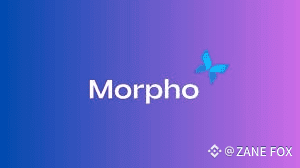
Morpho is a decentralized, non-custodial lending protocol built for Ethereum and other EVM-compatible blockchains. It was created to make lending and borrowing on-chain more efficient and fair, offering users better interest rates and more flexible terms while keeping their funds fully under their control. Unlike traditional lending platforms that simply pool funds together, Morpho adds a smart matching layer that can pair borrowers and lenders directly, improving the experience for both sides.
In its early version, Morpho acted as an optimizer. It routed funds through existing lending pools but tried to match lenders and borrowers peer-to-peer whenever possible. If a match could be found, lenders would earn slightly higher yields, and borrowers would pay lower interest. When no direct match was available, the system used the underlying pools to keep funds productive and secure. This approach allowed Morpho to gain traction quickly, as users immediately saw the benefit of better rates without taking on extra risk.
Morpho evolved into its second version, V2, which goes far beyond simple optimization. V2 introduces an intent-based architecture where users and builders can specify exactly what they want from a loan or deposit. A lender can request a fixed-term loan at a set interest rate, while a borrower can define the duration and type of collateral they wish to use. The system then intelligently matches these intents across the network, making lending more predictable and efficient. V2 also supports vaults, which are smart pools that allow curators to manage capital with custom rules, linking to different markets or strategies to maximize yield and reduce risk.
The way Morpho works is straightforward. When a user deposits an asset, the protocol first attempts to find a borrower directly through its matching system. If a match is found, the transaction occurs at improved rates for both parties. If not, the funds are deposited into an underlying pool where they continue to earn interest safely. Borrowers benefit in the same way, as the system searches for lenders willing to provide better rates than standard pools. All of this is handled automatically by smart contracts, ensuring transparency and trustlessness.
Morpho also includes a governance layer, powered by its native token, MORPHO. Token holders can vote on key decisions, such as which oracles to use, how risk parameters are defined, and the creation of new markets. This decentralized governance aligns the incentives of users, developers, and the wider community. The token can also be earned through participation in lending, borrowing, and vault activity, providing additional incentives for active users.
Safety has always been a key focus for Morpho. By building on top of established lending pools, the protocol inherits many of their security guarantees. Its own contracts are designed to isolate risk, and the code has undergone audits to ensure reliability. Vaults and markets are carefully structured to manage exposure, and liquidation processes follow clear rules to protect both borrowers and lenders. As with any decentralized finance platform, there are risks. Smart contract bugs, oracle failures, and market volatility can all impact outcomes, so users are encouraged to understand the protocol before engaging heavily.
The benefits of using Morpho are tangible. Lenders can earn higher yields thanks to peer-to-peer matching, borrowers can access loans at lower rates, and both can do so without giving up control of their assets. Developers and institutions can build specialized markets or vaults tailored to specific strategies or risk preferences, making the platform highly flexible. With cross-chain support, Morpho is not limited to Ethereum alone and can serve a wider range of users.
Morpho represents a thoughtful evolution in decentralized lending. It balances the security and liquidity of established pools with the efficiency and flexibility of direct matching and customizable markets. By doing so, it opens opportunities for retail users, developers, and institutions to participate in lending in ways that were not possible before. Its combination of efficiency, transparency, and adaptability makes it one of the most promising platforms in the evolving decentralized finance landscape.
Morpho is especially interesting because it started by solving a simple problem, providing better rates for users, but has grown into a robust network that can support complex lending strategies, fixed-rate loans, and tailored markets. For anyone interested in decentralized finance, whether as a lender, borrower, or builder, Morpho offers a compelling set of tools and a vision for the future of on-chain lending. It is a platform designed to make decentralized finance smarter, more accessible, and more aligned with the needs of its users while staying true to the core principles of decentralization and security.



